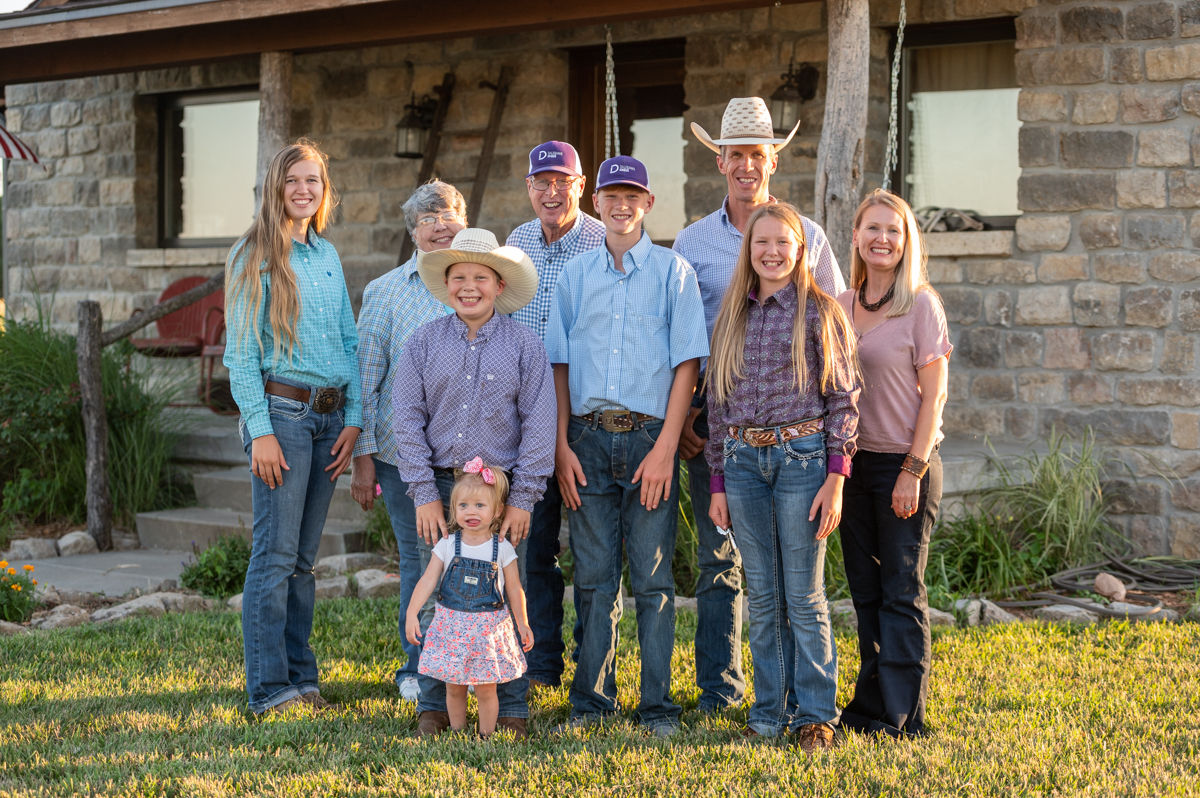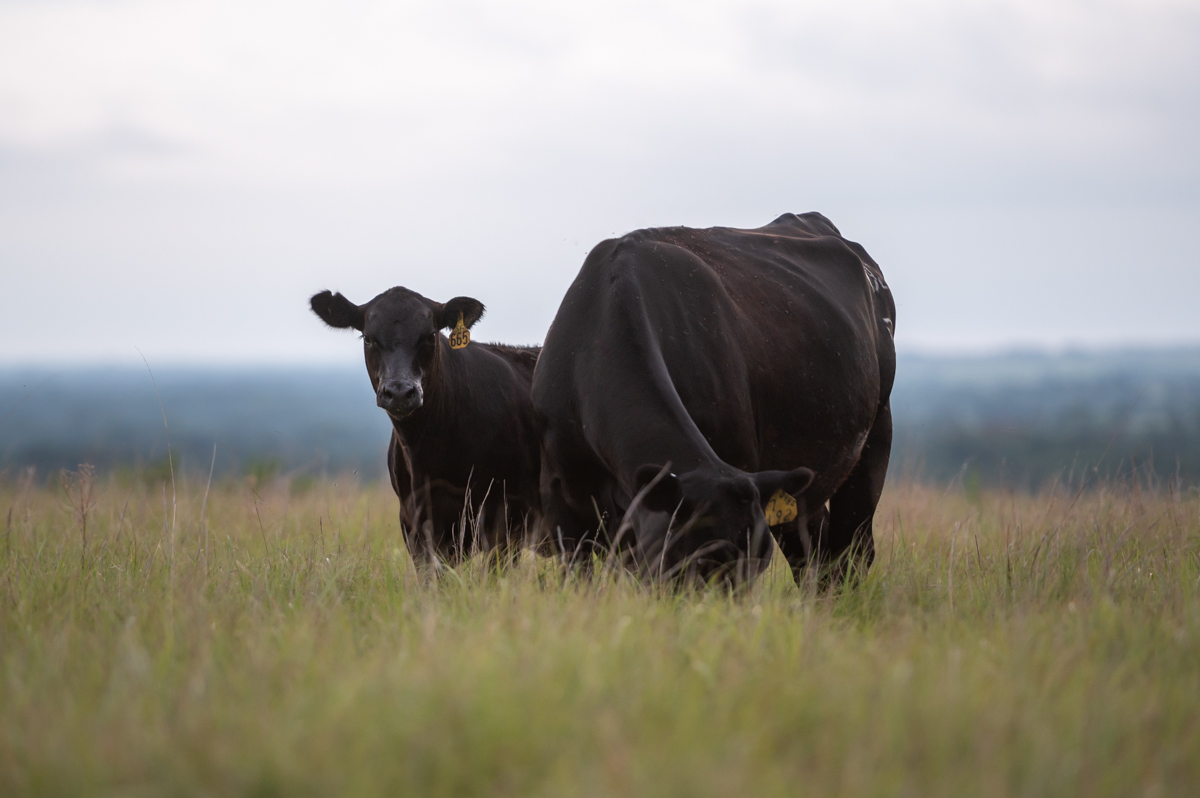
Dalebanks Angus earns CAB seedstock honors
by Miranda Reiman
September 24, 2020
Doing right by their customers means raising the best cattle they can. For the Perrier family of Eureka, Kansas, that’s a philosophy, business model and family code all wrapped into one.
Matt, Amy and their children, along with his parents Tom and Carolyn Perrier operate Dalebanks Angus. The designation traces back to ancestors who kept a bit of their English heritage alive with their farm name when they settled the Kansas plains.
“Our breeding philosophies are generations deep,” Matt Perrier says. His great-grandpa saw these “unique” cattle at the American Royal in 1903, and brought the first Angus to their ranch the next year. Then his grandpa crafted a simple phrase, which the family has further distilled to the tagline for their whole program: “Practical, profitable genetics.”
The Perriers say strength in their customers’ bottom line means strength in their own, and profitability has to happen at every step along the beef chain.
Dalebanks Angus recently earned the 2020 Seedstock Commitment to Excellence Award from the Certified Angus Beef ® (CAB®) brand.

Always improving
As a boy, Perrier remembers concerns with lower beef demand and a fledgling high-quality Angus beef brand. Anyone who thought CAB was a real target?
“They got laughed at,” he says. “When I see that logo, I see folks who believed there was a reason to breed cattle that met consumers’ demand. I see folks who shrugged their shoulders and said, ‘I don’t care that the rest of the industry is telling us to go the exact opposite way.’”
Yet, it took an entire shift in the industry before it made sense to everyone.
“We needed a way for cattle—that were more desirable for our consumer—to get rewarded for that kind of production. It wasn’t happening in the ’80s and early ’90s,” his father says. “Now it has accomplished what it set out to do…and I’m glad that we’ve been a little part of that.”
It’s one of the reasons his son carries on the tradition of keeping cattle consistent, moderate in size and balanced for all traits, while making improvements on multiple fronts.

“We know we could breed cattle that are fancier, but we also know through the centuries, our customers have looked to us, not just for prettier cattle or cattle that excel in one trait, but that are profitable for them,” Perrier says.
The sale book is full of cattle that bear the Targeting the Brand logo, signifying bulls with a higher likelihood of siring calves that reach 50% CAB brand acceptance or better. The 2019 book featured 109 bulls with the mark, or 73% of their offering.
“Hopefully that proves, even though we breed for bulls and females that are of exceptional maternal value, we’re making simultaneous improvement in both of those areas,” he says.
Perrier spent seven years as a Regional Manager and later Director of Commercial Programs for the American Angus Association and Tom served on the board in the ’80s—they both know programs only work with participants and advancements in breed only happen when the data informs tools.
“We still have to recognize that Mother Nature and the environment we’re in is either a pretty powerful ally or enemy,” Perrier says. “If we try to use technology and overcome her completely and feed our way out of ‘problem cattle’ to cover up an issue in the genetics that should have been allowed to show, then we get ourselves in trouble.”
So he’s honest with himself and the cattle are honest with him. They learn to walk to water and travel on the rocks and hills, or they don’t stay.


But the family that came back to the ranch? They’re here for the long haul.
“I watched my mom and dad fight through the ’80s and keep the thing together. I heard stories about my grandmother and others in the family keeping it together though the Depression and a couple of world wars and everything else,” Perrier says. “There was a certain amount of duty that I felt, that I had to make sure it didn’t end with my generation.”
Ava was a baby when they made the move back home. Now 17, she’s a big help on the ranch, along with her siblings Lyle (14), Hannah (11), Henry (9) and Hope (1½).
There’s plenty of opportunities for teaching and observing, both technical skill and the value of hard work. It’s proven a great place to learn about life.
“We try to be constant learners and get better every day in whatever we’re doing. With our faith, with our sports and activities, with our school and learning and with our work around here,” Perrier says. “We try to make ourselves and those around us better every day.”
CAB recognized its 2020 honorees at the brand’s virtual annual conference on September 23 and 24.
You may also like
$100,000 Up for Grabs with 2024 Colvin Scholarships
Certified Angus Beef is offering $100,000 in scholarships for agricultural college students through the 2024 Colvin Scholarship Fund. Aspiring students passionate about agriculture and innovation, who live in the U.S. or Canada, are encouraged to apply before the April 30 deadline. With the Colvin Scholarship Fund honoring Louis M. “Mick” Colvin’s legacy, Certified Angus Beef continues its commitment to cultivating future leaders in the beef industry.
Raised with Respect™ Cattle Care Campaign Launched This Fall
Raised with Respect™ was developed as part of a strategic cattle care partnership between Sysco and CAB. The collaboration focuses on supporting farmers and ranchers, equipping them with continuing education to stay current on best management practices and helping to increase consumer confidence in beef production.
Drought Impact and Cattle Industry Dynamics
As drought conditions persist across much of cattle country, farmers and ranchers are at a pivotal juncture in the cattle industry’s landscape. What impact does this prolonged dry spell have on the nation’s herd numbers? When will heifer retention begin? How will industry dynamics influence the spring bull sale season?



